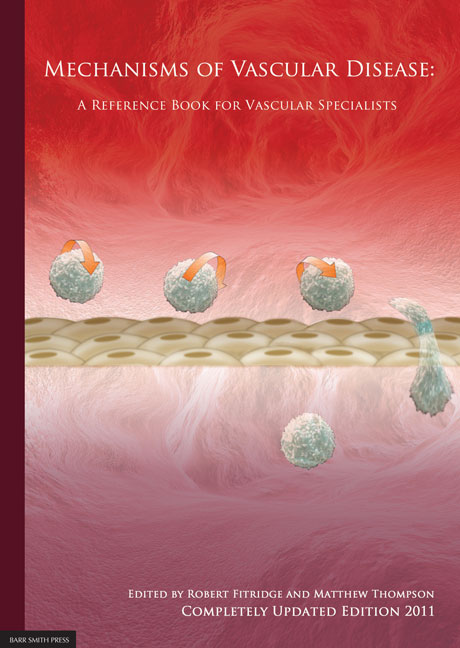Book contents
- Frontmatter
- Contents
- List of Contributors
- Detailed Contents
- Acknowledgements
- Abbreviation List
- 1 Endothelium
- 2 Vascular smooth muscle structure and function
- 3 Atherosclerosis
- 4 Mechanisms of plaque rupture
- 5 Current and emerging therapies in atheroprotection
- 6 Molecular approaches to revascularisation in peripheral vascular disease
- 7 Biology of restenosis and targets for intervention
- 8 Vascular arterial haemodynamics
- 9 Physiological Haemostasis
- 10 Hypercoagulable States
- 11 Platelets in the pathogenesis of vascular disease and their role as a therapeutic target
- 12 Pathogenesis of aortic aneurysms
- 13 Pharmacological treatment of aneurysms
- 14 Pathophysiology of Aortic dissection and connective tissue disorders
- 15 Biomarkers in vascular disease
- 16 Pathophysiology and principles of management of vasculitis and Raynaud's phenomenon
- 17 SIRS, sepsis and multiorgan failure
- 18 Pathophysiology of reperfusion injury
- 19 Compartment syndromes
- 20 Pathophysiology of pain
- 21 Post-amputation pain
- 22 Treatment of neuropathic pain
- 23 Principles of wound healing
- 24 Pathophysiology and principles of varicose veins
- 25 Chronic venous insufficiency and leg ulceration: Principles and vascular biology
- 26 Pathophysiology and principles of management of the diabetic foot
- 27 Lymphoedema – Principles, genetics and pathophysiology
- 28 Graft materials past and future
- 29 Pathophysiology of vascular graft infections
- Index
6 - Molecular approaches to revascularisation in peripheral vascular disease
Published online by Cambridge University Press: 05 June 2012
- Frontmatter
- Contents
- List of Contributors
- Detailed Contents
- Acknowledgements
- Abbreviation List
- 1 Endothelium
- 2 Vascular smooth muscle structure and function
- 3 Atherosclerosis
- 4 Mechanisms of plaque rupture
- 5 Current and emerging therapies in atheroprotection
- 6 Molecular approaches to revascularisation in peripheral vascular disease
- 7 Biology of restenosis and targets for intervention
- 8 Vascular arterial haemodynamics
- 9 Physiological Haemostasis
- 10 Hypercoagulable States
- 11 Platelets in the pathogenesis of vascular disease and their role as a therapeutic target
- 12 Pathogenesis of aortic aneurysms
- 13 Pharmacological treatment of aneurysms
- 14 Pathophysiology of Aortic dissection and connective tissue disorders
- 15 Biomarkers in vascular disease
- 16 Pathophysiology and principles of management of vasculitis and Raynaud's phenomenon
- 17 SIRS, sepsis and multiorgan failure
- 18 Pathophysiology of reperfusion injury
- 19 Compartment syndromes
- 20 Pathophysiology of pain
- 21 Post-amputation pain
- 22 Treatment of neuropathic pain
- 23 Principles of wound healing
- 24 Pathophysiology and principles of varicose veins
- 25 Chronic venous insufficiency and leg ulceration: Principles and vascular biology
- 26 Pathophysiology and principles of management of the diabetic foot
- 27 Lymphoedema – Principles, genetics and pathophysiology
- 28 Graft materials past and future
- 29 Pathophysiology of vascular graft infections
- Index
Summary
INTRODUCTION
Currently, treatment options for peripheral vascular disease include angioplasty and reconstructive surgery. An attractive, less invasive alternative could involve the revascularization of ischaemic tissue by the induction of vascular growth. It would be particularly welcome for patients in whom current approaches are difficult or prone to failure, including those with conditions that make surgical intervention unsafe, patients with diffuse occlusive disease and those in whom there is significant downstream microvascular disease. Recent years have witnessed major advances in the understanding of the molecular mechanisms underlying vascular formation and remodelling, as well as the identification of key molecules controlling these processes. Most research has focused on the induction of new vessel formation by stimulating angiogenesis and this has been the goal of the clinical trials directed at peripheral vascular disease. But, whilst the stimulation of angiogenesis may relieve microvascular disease, the bypass of occluded conduit vessels requires the formation of more substantial collateral vessels by the process of arteriogenesis. This chapter will review current understanding of the mechanisms controlling angiogenesis and arteriogenesis; approaches that are, and could be pursued to induce vessel growth in peripheral vascular disease, as well as summarizing the current status of clinical trials.
MECHANISMS OF VASCULAR GROWTH
Strategies currently being developed for the therapeutic induction of vessel growth have evolved, largely, from knowledge of the physiological mechanisms of developmental vascularisation. In development, blood vessels arise initially by the process of vasculogenesis during which precursor cells, known as angioblasts, differentiate into endothelial cells and organize into primitive vessels.
- Type
- Chapter
- Information
- Mechanisms of Vascular DiseaseA Reference Book for Vascular Specialists, pp. 103 - 114Publisher: The University of Adelaide PressPrint publication year: 2011

